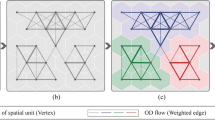Abstract
The commuting behavior of private cars is the main cause of traffic congestion in the morning and evening rush hours. The discovery of stable ride-sharing groups for commuting private car is a necessary work to solve the morning and evening peak traffic congestion, and the discovery of ride-sharing groups is to match similar travelers. But different from the traditional ride sharing service based on passenger request, commuting private car users expect a long-term stable ride sharing service. This paper proposed a commuting private car ride-sharing groups discovery model based on spatio-temporal semantic similarity. The model considers the similarity of commuting time and space, and adds the user feature of commuting workplace’s semantics to provide stable sharing matching for commuters of similar occupations, and adds the semantic of commuting place to provide stable ride-sharing matching for commuters with similar occupations. Commuting workplace’s semantics refers to the functional area type of commuting workplace, which can reflect the nature of commuters' work. The main research content includes two parts: functional area identification and ride-sharing groups’ discovery. In the process of functional area recognition, based on POI and road network data, multi classification support vector machine is used to identify urban functional areas. In the process of ride-sharing groups’ discovery, based on the travel data of commuter private cars, DBSCAN clustering algorithm with spatio-temporal semantic distance measurement is used to complete ride-sharing group discovery.
Access this chapter
Tax calculation will be finalised at checkout
Purchases are for personal use only
Similar content being viewed by others
References
Diao, M., Kong, H., Zhao, J.: Impacts of transportation network companies on urban mobility. Nature Sustain. 4(6), 494–500 (2021). https://doi.org/10.1038/s41893-020-00678-z
González, M., Hidalgo, César. A., Barabási, A.-L.: Understanding individual human mobility patterns. Nature 453(7196), 779–782 (2008). https://doi.org/10.1038/nature06958
Çolak, S., Lima, A., González, M.: Understanding congested travel in urban areas. Nature Commun. 7(1), 10793 (2016). https://doi.org/10.1038/ncomms10793
Want, R.: An introduction to RFID technology. IEEE Pervasive Comput. 5(1), 25–33 (2006)
Savelsbergh, E.A., et al.: Optimization for dynamic ride-sharing: a review. 15(3), 13–15 (2002)
Santi, P., Resta, G., Szell, M., et al.: Quantifying the benefits of vehicle pooling with shareability networks. Proc. Natl. Acad. Sci. U.S.A. 111(37), 13290–13294 (2014)
He, W., Hwang, K., Li, D.: Intelligent carpool routing for urban ridesharing by mining GPS trajectories. IEEE Trans. Intell. Transp. Syst. 15(5), 2286–2296 (2014)
Hong, Z., Chen, Y., Mahmassani, H.S., et al.: Commuter ride-sharing using topology-based vehicle trajectory clustering: methodology, application and impact evaluation. Transp. Res. Part C Emerg. Technol. 85, 573–590 (2017)
Wang, Z., et al.: Identifying urban functional areas and their dynamic changes in Beijing: using multiyear transit smart card data. J. Urban Plan. Dev. 147(2), 04021002 (2021). https://doi.org/10.1061/(ASCE)UP.1943-5444.0000662
Author information
Authors and Affiliations
Corresponding author
Editor information
Editors and Affiliations
Rights and permissions
Copyright information
© 2021 Springer Nature Switzerland AG
About this paper
Cite this paper
Ye, Y., Zheng, L., Chen, Y., Liao, L. (2021). Discovering Stable Ride-Sharing Groups for Commuting Private Car Using Spatio-Temporal Semantic Similarity. In: Qiu, H., Zhang, C., Fei, Z., Qiu, M., Kung, SY. (eds) Knowledge Science, Engineering and Management . KSEM 2021. Lecture Notes in Computer Science(), vol 12816. Springer, Cham. https://doi.org/10.1007/978-3-030-82147-0_52
Download citation
DOI: https://doi.org/10.1007/978-3-030-82147-0_52
Published:
Publisher Name: Springer, Cham
Print ISBN: 978-3-030-82146-3
Online ISBN: 978-3-030-82147-0
eBook Packages: Computer ScienceComputer Science (R0)





